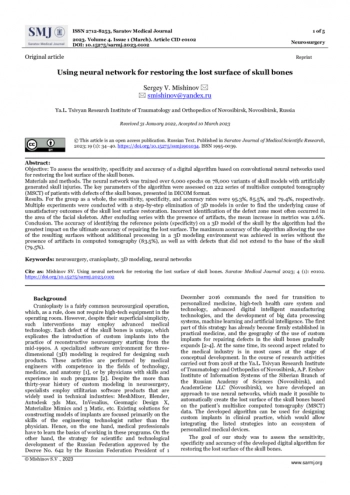Objective: To assess the sensitivity, specificity and accuracy of a digital algorithm based on convolutional neural networks used for restoring the lost surface of the skull bones.
Materials and methods. The neural network was trained over 6,000 epochs on 78,000 variants of skull models with artificially generated skull injuries. The key parameters of the algorithm were assessed on 222 series of multislice computed tomography (MSCT) of patients with defects of the skull bones, presented in DICOM format.
Results. For the group as a whole, the sensitivity, specificity, and accuracy rates were 95.3%, 85.5%, and 79.4%, respectively. Multiple experiments were conducted with a step-by-step elimination of 3D models in order to find the underlying cause of unsatisfactory outcomes of the skull lost surface restoration. Incorrect identification of the defect zone most often occurred in the area of the facial skeleton. After excluding series with the presence of artifacts, the mean increase in metrics was 2.6%. Conclusion. The accuracy of identifying the reference points (specificity) on a 3D model of the skull by the algorithm had the greatest impact on the ultimate accuracy of repairing the lost surface. The maximum accuracy of the algorithm allowing the use of the resulting surfaces without additional processing in a 3D modeling environment was achieved in series without the presence of artifacts in computed tomography (83.5%), as well as with defects that did not extend to the base of the skull (79.5%).




